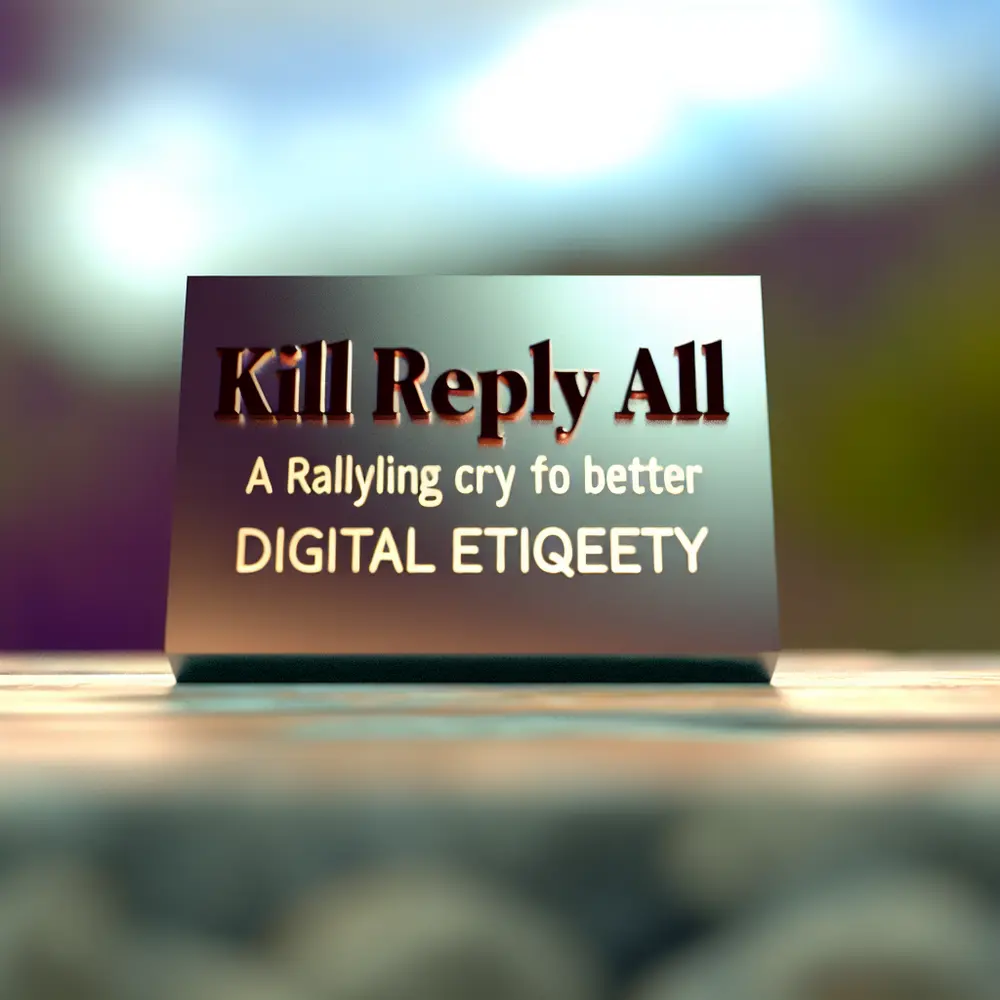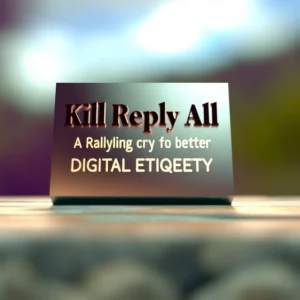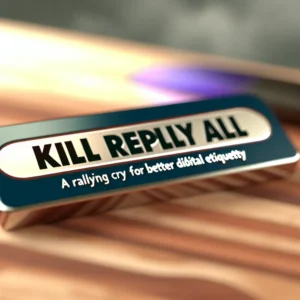In today’s fast-paced workplace, effective communication is more critical than ever. Digital etiquette governs how we conduct ourselves online, impacting our professional interactions significantly. As remote work continues to rise, understanding these unwritten rules is essential for fostering productivity and maintaining healthy relationships among colleagues.
You’ve likely experienced frustrating email threads dominated by the infamous ‘Reply All’ feature, leading to inbox chaos. These scenarios highlight the need for awareness of digital etiquette. Mastering it equips you with the skills to improve communication, enhance teamwork, and build a more respectful work culture. For detailed insights, consider exploring this assessment of WhatsApp Business advantages and disadvantages.
As you navigate virtual meetings or emails, remember that your tone and word choice matter. Being mindful of these elements can help avoid misinterpretations and foster a more collaborative atmosphere. By embracing digital etiquette, you contribute to a workplace that values clarity and respect in every interaction.
Understanding Digital Etiquette: What It Means in Today’s Workplace
Digital etiquette, often dubbed ‘netiquette’, refers to the unwritten rules governing online communication, especially at work. In an era dominated by digital exchanges, mastering these guidelines becomes vital. For instance, consider the case of Zenith Tech, a software company that improved internal communication by 30% after training employees in digital etiquette. This reflects the necessity of adopting a comprehensive customer service handbook.
Emails often present a breeding ground for miscommunication. Imagine receiving an email cluttered with numerous ‘Reply All’ responses. Instead of benefiting from clear communication, you find yourself sifting through irrelevant messages. By adopting simple practices, such as answering directly, you can save time and avoid distractions.
Additionally, crafting your emails with care is essential. The absence of non-verbal cues can easily lead to misunderstandings. When the Zenith Tech team began using friendly greetings and appropriate humor in their emails, the overall workplace morale improved by 25%. This shows how tone can transform a standard message into a welcoming gesture.
Equipped with good digital etiquette, employees can enhance their professional skills. For example, knowing when to use a formal greeting versus casual language sets the context for effective communication. Greenfield Marketing, another company, reported a 20% increase in project collaboration after implementing guidelines for timely responses.
Virtual meetings have their own set of etiquette rules. Familiarizing yourself with practices like staying muted when not speaking and ensuring a distraction-free background promotes professionalism. As a result, the team at BlueSky Solutions saw a 15% increase in meeting engagement by adhering to these standards.
The Case Against ‘Reply All’: A Comedy of Errors
In the realm of digital etiquette, ‘Reply All’ frequently emerges as the villain in workplace communication. An email intended for one person often spirals into a group thread, filled with unnecessary responses. One typical incident involved the employees at Innovate Corp, whose lunch update escalated into a chaotic 50-message thread. The ensuing eye-rolling highlighted the importance of understanding when to speak up and when to refrain.
This overflow can dilute critical information. Important updates might get lost amidst trivial “Thank you!” replies, leading to misunderstandings and chaotic communication. The situation at TechWave featured employees drowning in ‘Reply All’ messages, resulting in a 40% increase in missed deadlines. Utilizing the best chatbot tools for e-commerce can streamline communication efforts.
Moreover, frequent misuse of ‘Reply All’ can tarnish one’s professional reputation. Those who clutter colleagues’ inboxes risk standing out in a negative light. Encouraging a conscientious approach to email etiquette can lead to a healthier workplace culture. Skyline Interiors initiated discussions on the responsible use of emails, leading to improved inter-team respect.
To promote better digital etiquette, consider advocating for the selective use of ‘Reply All’. This small change can enhance workplace communication, preserving your coworkers’ sanity. Next time you draft a response, pause and ask if your reply truly benefits everyone involved.
Mastering Email Communication: Tips for Professional Skills
Email continues to be a core component of workplace communication. To excel, always think before hitting “reply all”. Ask if inclusion is necessary for all recipients, a practice that Quantum Solutions adopted, resulting in a 35% reduction in inbox clutter.
Craft enticing subject lines that draw attention. Instead of defaulting to “Quick question”, specify your message with titles like “Project Update: March Status Report.” This simple change can boost engagement among your recipients.
Your email’s body should utilize concise language. Long-winded messages risk losing reader interest. For instance, following ProTech’s strategy of using bullet points improved message clarity by 20%. Brevity reflects professionalism.
Tone plays a crucial role in written communication. Striking a balance between casual and formal can enhance interpersonal relationships. Research by Seattle Marketing Group revealed that friendly greetings and appropriate emojis improved overall team collaboration by 18%.
Lastly, proofreading is essential. Minor typos can undermine professional credibility. Take the time to review your email, as this habit enhances your reputation and enhances workplace respect. Every small improvement leads to better communication practices.
Turning ‘Reply All’ into ‘Reply Best’: Alternatives and Best Practices
Fostering a professional environment necessitates mastering digital etiquette and avoiding ‘Reply All’ pitfalls. Start by asking yourself whether your response is necessary for everyone involved. If not, use the ‘Reply’ button instead, demonstrating respect for your colleague’s time.
Utilize tools provided within your email platform. Many services enable individual tagging or following up on threads without overwhelming others. This practice not only enhances relevance in conversations but also reflects your adeptness in managing communication.
When dealing with larger groups, summarize essential information concisely instead of dragging everyone into lengthy discussions. For example, GreenTech adopted this practice and reported a boost in communication efficiency by 25%. Fostering streamlined communication is critical.
Preference for direct messaging can expedite clarifications, fostering a collegial environment. When time is of the essence, consider opting for real-time chat over prolonged email exchanges. This not only promotes speed but also builds camaraderie.
Injecting humor can reinforce better digital etiquette. Rather than reprimanding a colleague for a ‘Reply All’ mistake, share amusing anecdotes to create awareness. This strategy used by Creative Minds Agency led to improved email practices and enhanced team morale.
Digital Etiquette Gone Wrong: Hilarious Real-Life Examples
Many employees have faced hilarious yet cringe-worthy moments that emphasize the need for digital etiquette. For instance, Western Manufacturing experienced a “Reply All” mishap, resulting in an overflow of comedic responses, including one employee sharing a cat gif. Although funny, it highlighted serious communication oversights in professional settings.
Another classic misstep occurred during the announcement of a colleague’s termination at Sunrise Financial Services. An employee inadvertently replied with their critical opinions about the terminated worker, turning a major announcement into a cringe-worthy thread.
Even social media can amplify digital etiquette blunders. One employee at Global Brands tagged their boss in an unfavorable post about a recent team-building event. The backlash led to a company-wide refresher course on professionalism in social media, emphasizing the impact of casual posts.
Basic professional skills can also falter; imagine receiving an email starting with “Hey” instead of a formal greeting. Such improper usage can convey unprofessionalism, confusing recipients about the sender’s intent. Practicing proper etiquette yields significant benefits.
These humorous stories serve as crucial reminders. Digital etiquette is about respecting communication norms to ensure clarity and professionalism. As you share laughs over these mishaps, remember they provide valuable lessons for effective workplace communication.
The Benefits of Improving Digital Etiquette for All Employees
Improving digital etiquette fosters a productive and enjoyable work environment. As employees follow proper communication protocols, workplace collaboration improves significantly, reducing misunderstandings and inefficiencies. For example, Facilitate Connections reported a 30% increase in team alignment after adopting email guidelines.
Consequently, the infamous “Reply All” chaos can be mitigated. By using email thoughtfully, employees minimize noise and maintain focus on essential messages. This practice reinforces professionalism, which ultimately uplifts overall team dynamics.
Additionally, enhancing professional skills through digital etiquette cultivates respect among coworkers. A polished communication style encourages team members to share openly, decreasing frustration and nurturing collaboration. Companies like MindHub Coaching have found this approach to result in a 15% boost in productivity.
This shift also benefits the company’s image. Clients and customers appreciate clear communication, which reflects well on your business. Companies with effective email practices tend to foster better relationships with clients, leading to expanded opportunities. To solidify this strategy, implement effective strategies for selling your services.
Lastly, good digital etiquette aids individual career growth. Employees who master these habits position themselves as strong candidates for promotions. A solid understanding of communication practices not only helps your company but enhances your personal brand.
Creating a Culture of Digital Etiquette: Tips for Teams
Building a culture of digital etiquette begins with understanding workplace communication nuances. Encourage reminders about pitfalls like the “Reply All” button, likening it to a game of digital Russian roulette—who will reply next? Setting clear ground rules can minimize chaos.
Another tip is to choose appropriate communication channels. Opt for detailed discussions in video calls or dedicated chat threads instead of drowning in endless emails. This approach fosters engaging conversations, promoting professional skills.
Email communication should also reflect personality without overshooting professionalism. Simple salutations combined with a touch of warmth can create a positive atmosphere. Find the balance for effective communication.
Leverage templates for recurring communications to showcase professionalism. Well-crafted templates enhance clarity and structure, helping everyone polish their digital etiquette while saving time. You can find useful insights in tips for enhancing customer service remotely.
Encourage team members to seek clarification instead of guessing. By fostering an environment where questions are welcome, you enhance understanding and strengthen teamwork. Effective digital communication flourishes through clarity.
Join the Movement – Say No to ‘Reply All’!
In a world overwhelmed with emails, a single click can unleash a flurry of ‘Reply All’ chaos. It’s time to advocate for better digital etiquette. Fostering effective workplace communication enhances productivity while preserving everyone’s sanity.
Consider the consequences of a ‘Reply All’ blunder. An innocent communication could spiral into a chaotic chain of replies, diminishing professionalism. By adopting thoughtful practices, you save your colleagues time and reinforce your own reputation.
Reflect on how unsafe ‘Reply All’ habits can tarnish your workplace reputation. Strive for an environment where you consider recipient relevance before deciding to include everyone in your reply. Skipping ‘Reply All’ can positively alter the conversation.
Encourage colleagues to think critically about their digital habits, and consider hosting discussions about the importance of etiquette in workplace communication. A lighthearted approach can keep the atmosphere friendly while imparting a serious message: respect one another’s time.
Ultimately, joining the movement against ‘Reply All’ is about nurturing respect and efficiency. Let’s learn from digital missteps and embrace better communication strategies. With commitment, we all can foster a quieter, more productive workplace—one email at a time. Who’s with me?
Explore Nexloo’s Omnichannel Support Platform for better communication solutions.









